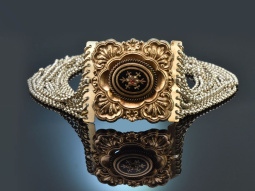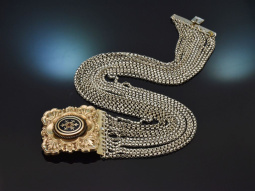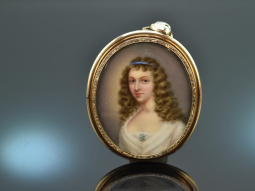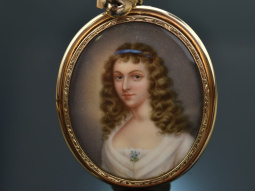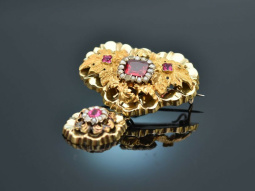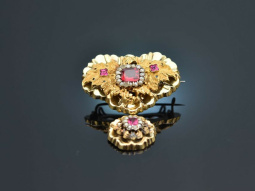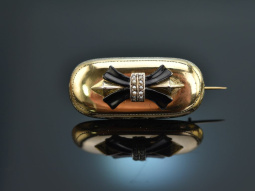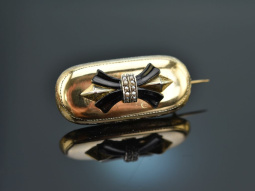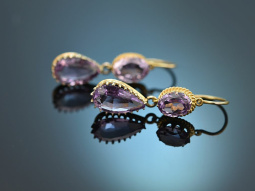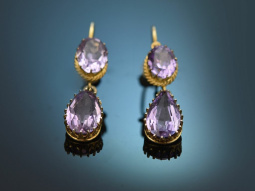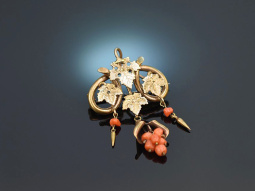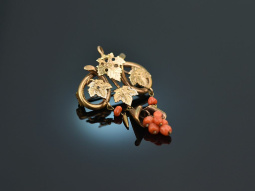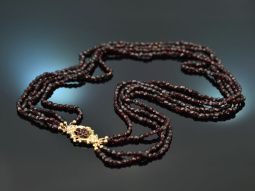Biedermeier
(1820 - 1870)
The Biedermeier period lies between Classicism and Historism and roughly covers the years between 1820 and 1870. After the long Napoleonic Wars, art and culture in the Biedermeier period were characterised by a return to the private sphere and nature. The bourgeoisie gained new self-confidence and wanted to dress and adorn themselves like the nobility, meaning that the demand for jewellery was high and very diverse. Brooches, bracelets and earrings were very popular, but also friendship and keepsake jewellery, for example. Find out more
An overview of the Biedermeier period
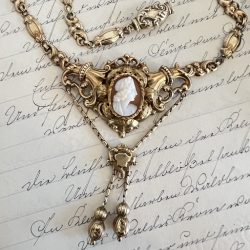
The Biedermeier period encompasses the time between the Congress of Vienna and the 1848 Revolution and ends in the late Biedermeier period around 1870. This era was characterised on the one hand by political censorship and state controls, and on the other by a very romantic society that withdrew primarily into the private domestic sphere and expressed its strengthened bourgeois self-confidence through home decor, art, music and literature.
The term Biedermeier is derived from parodistic poems about the philistine bourgeoisie by Adolf Kussmaul and Ludwig Eichrodt.
The cultural centres of the era were in Switzerland, Austria, Germany and Scandinavia. The entire period was characterised by a variety of styles and their mixtures: for example, Romanticism, late Classicism, Realism and Historism were also noticeable at the same time as Biedermeier.
What makes Biedermeier jewellery so special?
Popular pieces of jewellery from the Biedermeier period include chains and necklaces, brooches, pendants, medallions, bracelets and earrings, which still inspire us today with their floral elements and filigree decorations. Numerous pieces of jewellery from this period were also made as a sign of friendship or remembrance and therefore had a high sentimental value. In general, friendship and mourning jewellery was of high social relevance at the time. Portrait miniatures or bracelets made from hair were worn openly and were not only intended for silent mourning in private. Commemorative or mourning rings, for example, were commissioned before one's own death and then distributed to selected relatives and friends at the funeral service.
Souvenir jewellery, for example made of small glass mosaics, lava cameos, coral or shell gems, which were acquired on the so-called Grand Tour, the journey to the ancient cities of Italy, was also a characteristic feature of this period.
The influences of nature can be clearly seen in the jewellery of the Biedermeier period: For example, flowers and foliage were reproduced in gold or garnet. Decorative ornamental elements such as volutes, pendulums and cords surround cartouche-shaped designs, which were often decorated in the middle with a miniature, a gemstone or a cameo.
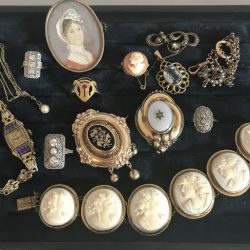
Pieces of jewellery often used precious stones typical of the region, such as garnet from Bohemia, but also coral from Italy or turquoise from the English colonies. Their decoration became more opulent and ornate overall. To save material, gold was rolled thin and pressed into fully plastic objects, which were then filled with putty, resin and sand to stabilise them (so called foam gold). Metal alloys such as tombac and pinchbeck were also often used to imitate gold in terms of colour. Even iron found its way into jewellery production. The so-called Fer de Berlin resembles delicate black lace and is very popular even today.
Generally, brooches became the preferential form of jewellery and bracelets with an accentuated middle section were also popular.
Biedermeier jewellery at Halsbandaffaire
Discover our unique pieces such as bracelets, brooches and medallions that bring the Biedermeier era back to life.
Today, jewellery from the Biedermeier period can be combined particularly well with a classic, elegant style, but also with traditional costumes and dirndls. So take a look at Halsbandaffaire if you are looking for your very own unique historical piece!
